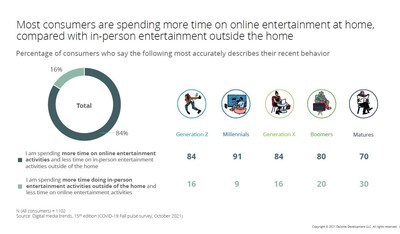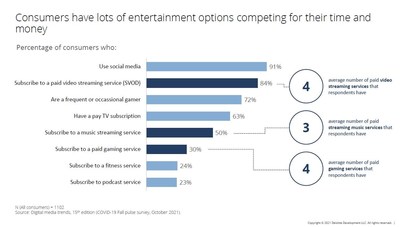Nearly two years into the pandemic, media companies face stiff competition for consumer loyalty from more interactive social media and gaming companies
Key takeaways
- Eighty-four percent (84%) of U.S. consumers say they are spending more time on online entertainment activities and less on in-person entertainment outside of the home recently. About the same percentage (82%) say they are concerned about COVID-19 variants, and that’s likely keeping people indoors and online.
- Boomers and Gen X still rank “watching TV shows or movies at home” as their favorite entertainment activity; Gen Z still rank “playing video games” as their preferred form of entertainment.
- Sixty-five percent (65%) of respondents are frequent gamers, playing at least once a week; on average, these frequent gamers play for around 12 hours a week.
- Sixty-five percent (65%) of consumers are engaging with at least one social media service several times a day.
- “Churn & return” behavior is most common with younger generations: Almost half of millennials (47%) and 34% of Gen Z cancelled and then resubscribed to the same streaming video service later that same year.
- The top reason consumers cancelled a paid streaming video on demand (SVOD) service was due to high cost followed by the fact they finished the show they signed up to watch.
- Sixty-five percent (65%) of consumers watch free ad-supported video services.
Marketing Technology News: Evolving Systems Enters Definitive Agreements to Sell Activation and Marketing Businesses to…
Why this matters
The continued uncertainty of the pandemic, and the spread of the Delta variant through the summer months kept consumers close to their households and plugged into online experiences. At the start of 2021, Deloitte launched its 15th annual “Digital Media Trends” survey which found that consumers had more time for home entertainment while streaming video providers were competing for subscribers against myriad entertainment options. In August of 2021, Deloitte fielded another survey of U.S. consumers, which revealed that changes shaped by the pandemic have continued and it’s becoming clear a return to the “old normal” is not imminent. For streaming video providers, keeping subscribers is harder than ever as people — especially younger generations — are managing costs by adopting ad-supported options, looking for discounts and bundles, and moving on and off services to satisfy their content needs. But COVID-19 could be ushering in a permanent shift in entertainment, where it’s not just about streaming, or the number of subscribers, but also importantly about how platform providers are responding to subscriber churn by providing enhanced experiences and the ability to connect with others on their platforms.
In-home entertainment still preferred
Deloitte’s most recent survey revealed that changes wrought by the pandemic are continuing, but compared to six months ago, consumers across generations have actually been spending more time watching TV and browsing the internet as they seek indoor entertainment options and avoid out-of-home experiences.
- Over 80% of U.S. respondents remain concerned about COVID-19 variants.
- When asked to describe their recent behavior, 84% of respondents say they are spending more time on online entertainment activities and less on in-person entertainment outside of the home.
- About half of consumers (48%) say they spend more time on online entertainment versus six months ago.
- Boomers and Gen X still rank watching TV shows or movies at home as their favorite entertainment activity.
- Gen Z, meanwhile, still rank playing video games as their preferred form of entertainment.
- Everyone younger than Boomers, especially Gen Zs and millennials, have been listening to music more than they were six months ago.
SVOD: Progressive providers, savvy subscribers
More premium and ad-supported services have launched, giving U.S. consumers additional options for watching new original content, and accessing a broad content library. The survey revealed that consumers are getting better at developing strategies to access this content while keeping their costs low.
- Eighty-four percent (84%) of respondents now pay for a SVOD service; the average household has four subscriptions — largely unchanged during the past year.
- The churn rate — the number of people who have cancelled, or both added and cancelled, a paid SVOD service — has remained stable at about 38%, although it varies from service to service.
- The top reason consumers cancelled a paid SVOD service was due to high cost followed by the fact they finished the show they signed up to watch.
- Many streaming video subscribers say they actively manage costs in some way, either by looking for deals or promotions, bundles, using friends’ or family members’ accounts, and other strategies.
- “Churn & return” behavior is common among younger generations. Almost half of millennials (47%) and 34% of Gen Z respondents cancelled and then resubscribed to the same service later. The top three reasons why Gen Z resubscribed: a new season of their favorite show was released; they routinely cancel and resubscribe to manage costs; or content they wanted to watch moved to the service.
- Led by cost-sensitive and savvy millennials and Gen Zs, 65% of respondents reported using free ad-supported video services.
“We’re seeing an important shift in what consumers are paying attention to and how they are choosing to engage and be entertained. While streaming video will continue to gain momentum, especially with leading services now pursuing global markets, these companies will also need to address churn and retention among diverse segments in different markets, and shift from merely measuring subscribers to understanding how to unlock the lifetime value within their customer bases. It will serve them well in the future to develop growth strategies that include both social video and social gaming, whether through partnerships, acquisitions, or simply establishing a really effective social media department.”
– Kevin Westcott, vice chairman, Deloitte LLP and U.S. technology, media and telecom leader
Marketing Technology News: Autokatalyst Acquires Cloud-Based Robotic Process Automation Platform OfficeBots
Social media: free, fast and flexible
The use of social media and online services is widespread among U.S. consumers and is a daily activity for many. Social apps are free and primarily mobile, reaching users wherever they are located. People are watching videos on social media, especially short videos made by average users and influencers. And with many consumers using these services, media and entertainment options are migrating onto them, and social commerce is booming.
- About 90% of respondents cited using at least one social media service, and the average person uses five different services. This number increases to seven for Gen Zs and millennials, with about a quarter of each using 10 or more different services.
- Sixty-five percent (65%) of consumers are engaging with at least one of these services several times a day.
- The top reasons for using social media are staying connected to friends and family (51%) and staying up to date on news and current events (31%). Discovering new content also ranked highly: 21% use social media to discover new video content, and 16% use it to discover new music.
- While a third of respondents say they are watching more video on paid streaming video services than they were six months ago, nearly as many say they are watching more video on social media and live streaming services.
- Forty-four percent (44%) of consumers follow an influencer on social media. Among consumers who follow an influencer, the top reason is liking the content they produce (53%). Other top reasons include relating to the influencer (35%), admiring them (29%) and liking the products they promote (29%).
- Roughly 4 in 10 U.S. respondents say that they have seen a product on social media and gone to the retailer’s website to buy it or clicked on an advertisement that led to a purchase.
- Thirty-one percent (31%) of respondents have made a purchase directly on a social media service. Younger consumers are more likely to find recommendations from influencers important to their purchasing decisions.
“It’s clear people still want to enjoy socializing with friends and family, even if that means the experience is online and the interaction is from within their homes. Streaming video in its current form doesn’t satisfy this social desire, so to meet this need, consumers are spending increasingly more time on other forms of online entertainment. Given this reality, streaming companies need to evolve their offerings into connected social experiences in order to keep subscribers interested and engaged, ultimately positioning their businesses for future growth amidst changing behaviors.”
– Jana Arbanas, vice chairman, Deloitte LLP and U.S. telecom, media and entertainment sector leader
Virtual gaming worlds continue to compete for entertainment time
Gaming and game-related content, such as live streams and video, continue to pose a threat to streaming video companies for consumers’ entertainment time. And, for many gamers, these activities have become much more social.
- Sixty-five percent (65%) of respondents are frequent gamers, playing at least once a week across devices like smartphones, consoles, tablets, portable gaming devices and computers.
- On average, frequent gamers play for around 12 hours a week. Gen Zs and millennials play closer to 13 or 14 hours weekly.
- Connecting with others is an important part of gaming. More than half of frequent or occasional gamers say “having positive interactions with others” is very or somewhat important to their overall gaming experience.
- Among frequent gamers, 45% are watching others stream their gameplay; 38% are streaming their own gameplay; and 49% are watching videos about gaming tips, cheats and tutorials on a monthly basis.
- Among frequent gamers, about 40% of Gen Zs and millennials play against other people online every day, and almost as many millennials (37%) are meeting up online to play with teammates daily.
- Forty-three percent (43%) of frequent gamers are purchasing skins, like virtual clothing, tattoos and hairstyles to represent themselves to other gamers, as well as gestures and dance moves known as “emotes,” to personalize their game characters monthly.
Marketing Technology News: MarTech Interview with Jay Kulkarni, Founder and CEO at Theorem













